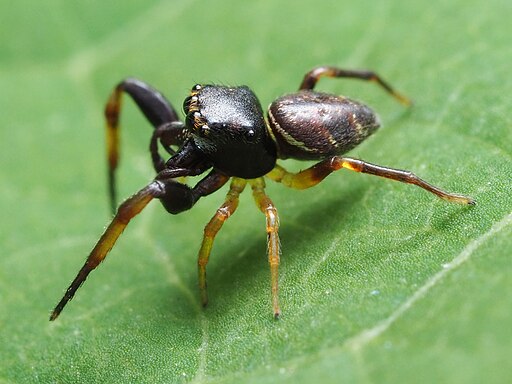Zygoballus rufipes Male
Zygoballus rufipes Female
Superregnum: Eukaryota
Regnum: Animalia
Subregnum: Eumetazoa
Cladus: Bilateria
Cladus: Nephrozoa
Cladus: Protostomia
Cladus: Ecdysozoa
Cladus: Panarthropoda
Phylum: Arthropoda
Subphylum: Chelicerata
Classis: Arachnida
Ordo: Araneae
Subordo: Opisthothelae
Infraordo: Araneomorphae
Taxon: Neocribellatae
Series: Entelegynae
Sectio: Dionycha
Superfamilia: Salticoidea
Familia: Salticidae
Genus: Zygoballus
Species: Zygoballus rufipes
Name
Zygoballus rufipes Peckham & Peckham, 1885

Zygoballus rufipes (*)
References
Primary references
Zygoballus rufipes, commonly called the hammerjawed jumper,[2] is a species of jumping spider which occurs in the United States, Canada, and Central America. Adult females are 4.3 to 6 mm in body length, while males are 3 to 4 mm.[3]
Taxonomy
The species was first described in 1885 by George and Elizabeth Peckham from a specimen in Guatemala.[4] The Peckhams subsequently described the northern variant as a separate species, Z. bettini, in 1888.[5] In 1980, after examining specimens of Z. bettini and Z. rufipes from various populations, G. B. Edwards concluded that the differences mentioned by the Peckhams were not consistently distinct and that the two names represented a single species of variable appearance.[6] The two names were therefore synonymized. The genus Zygoballus is currently classified in the subfamily Salticinae of the family Salticidae (jumping spiders).
Distribution
Zygoballus rufipes has been reported from Canada,[7] the United States,[8] Mexico,[9] Guatemala,[4] and Costa Rica.[10] In 1929, entomologist Nathan Banks reported a female specimen from Panama.[11] In 1946, however, arachnologist Arthur M. Chickering concluded that Banks' specimen belonged to the newly described species, Zygoballus optatus. Chickering himself found no specimens of Z. rufipes in Panama after collecting there for several years.[12] A one-year survey of Panamanian spiders conducted by zoologist Wolfgang Nentwig also failed to yield the species.[13]
References
"Taxon details Zygoballus rufipes Peckham & Peckham, 1885". World Spider Catalog. Natural History Museum Bern. Retrieved 2016-07-23.
"Common Names of Arachnids (2003)" (PDF) (5th ed.). The American Arachnological Society. 2003. p. 14. Retrieved 19 October 2021.
Kaston, Benjamin Julian (1981). Spiders of Connecticut (Revised ed.). State of Connecticut. pp. 496–497.
Peckham, George; Peckham, Elizabeth (1885). "On some new genera and species of Attidae from the eastern part of Guatemala" (PDF). Proceedings of the Natural History Society of Wisconsin: 62–86.
Peckham, George; Peckham, Elizabeth (1888). "Attidae of North America" (PDF). Transactions of the Wisconsin Academy of Sciences, Arts, and Letters. 7: 89–90.
Edwards, G. B. (December 1980). "Jumping spiders of the United States and Canada: changes in the key and list (4)" (PDF). Peckhamia. 2 (1): 11–14.
Maddison, Wayne P. (1996). "Pelegrina Franganillo and other jumping spiders formerly placed in the genus Metaphidippus (Araneae: Salticidae)". Bulletin of the Museum of Comparative Zoology. Harvard University. 154: 215–368.
Emerton, James Henry (1902). The Common Spiders of the United States. p. 48. ISBN 0-486-20223-2.
Pickard-Cambridge, Frederick O. (1897–1905). Arachnida: Araneidea and Opiliones. Volume II. Biologia Centrali-Americana. p. 291.
Reimoser, E. (1939). "Wissenschaftliche Ergebnisse der österreichischen biologischen Expedition nach Costa Rica: Die Spinnenfauna". Annalen des Naturhistorischen Museums in Wien (in German). 50: 328–386.
Banks, Nathan (1929). "Spiders from Panama". Bulletin of the Museum of Comparative Zoology. 69 (3): 51–96.
Chickering, Arthur M. (September 1946). "The Salticidae (Spiders) of Panama". Bulletin of the Museum of Comparative Zoology. 97: 404–414. hdl:2027/mdp.39015068348831.
Nentwig, Wolfgang (1993). Spiders of Panama. Sandhill Crane Press. p. 29. ISBN 1-877743-18-6.
Retrieved from "http://en.wikipedia.org/"
All text is available under the terms of the GNU Free Documentation License



